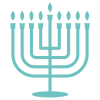As we approach the end of Hanukkah and 2024, I’m thinking and reflecting on the world I wish to see and the self I’d like to be.
For the last several years, I’ve used the end of the year as an opportunity to reflect and redesign the life I want. I wrote about my first real attempt at this for my 32nd birthday in March 2021. I created and implemented the framework just weeks before the pandemic took over our lives. You can find that here.
I’ll do it again this upcoming week, using my HEART framework and focusing on five core parts of my life I care about.

I find the journey and practice of personal growth meaningful. I like the idea of becoming a better person, so it drives a lot of my actions.
When we think about personal growth, there are two ways we construct and describe it in our language: actions and identities. For example, “I like to run” vs. “I am a runner.”
While there are advantages and disadvantages to using the language of one or the other, I like to use it this way: Actions are for things we want to change that are negative, and identities are positive qualities we want to emphasize.
I’ve told myself for years and years that “I’m not a morning person,” to the point that it’s a part of my identity. But is it? Should it be? What if I framed it as: “I haven’t woken up early consistently,” which is about the act instead of who I am?
In the Torah, when the people accept the Mitzvot from God on high, they respond נַעֲשֶׂה וְנִשְׁמָע, naase v’nishmah, which is often translated as: “We will do, and we will understand.”
This dichotomy can support our paradigm here. There are actions we will do and identities we will take on, but they aren’t exactly the same. That said, our actions impact who we are, just like the identities we take on. Both influence the person we will become at the end of the year, but in different ways.
As you reflect on what 2025 might bring for you, think about how you speak with yourself, what actions you want to focus on, and what identities you want to inhabit.
Here are some Hanukkah Torah tidbits that I’ve shared online that you might like!

As Hanukkah is upon us, a few Jewish values speak to me right now:
We don’t have all the answers, but a drive to find truth.
No one is perfect, but we can all be better.
That we never give up, retaining a yearning for a world more whole, kind, and supportive of each other.
Each are a light, a bright spot in the darkness that sometimes fills our hearts. I’m proud to be a Jew.

One principle that exists for Hanukkah is: Maalin b’Kodesh, going up in holiness. It is one reason given for why we add candles each night.
Holiness is easier to recognize when we consider others in our perspective.
Our holiness grows when we include others.
Our lights shine brighter with others beside us.

One of the lessons we can learn from the Shammai lighting model on Hanukkah (lighting eight on first night and then fewer each night) is:
Life can sometimes feel chaotic, overly bright, and busy.
As we remove distractions, we regain focus.
This is represented by the single candle at the end.Focus lets us utilize our energies for what matters.
It keeps us going in a direction.
It encourages us to strip away the meaningless drivel that’s filling our lives and, instead, listen the clear voices we need.Even though Shammai’s perspective on this ritual did not become dominant, it still has powerful wisdom to teach us.